Quantifying the Contribution of Forest Restoration to Wind Erosion Control Using RWEQ—A Case Study of Duolun County in Inner Mongolia, China
Highlights
- The Revised Wind Erosion Equation (RWEQ) model was applied to quantify wind erosion and sand fixation at fine spatial resolution.
- A scenario-based analytical framework was developed to isolate and quantify the specific contribution of forest restoration to wind-erosion control.
- Revealed that large-scale afforestation markedly enhanced regional wind erosion control capacity.
- Provides a quantitative basis for evaluating ecological restoration programs and guiding sustainable land management in arid and semi-arid regions.
Abstract
1. Introduction
2. Study Area and Data
2.1. Study Area
2.2. Data Sources
2.2.1. Meteorological Data
2.2.2. Remote Sensing Data
2.2.3. Soil Data
2.3. Land-Use Classification
2.4. RWEQ Model
2.5. Evaluation of Sand Fixation Benefits
2.6. Trend Analysis
3. Results
3.1. Land Use Classification and Forest Cover Change
3.2. Spatiotemporal Variations in Sand Fixation
3.3. Forest Expansion and Wind Erosion Control
4. Discussion
4.1. Spatiotemporal Dynamics and Mechanisms
4.2. Comparison with Previous Studies
4.3. Natural Factors Associated with the Change in Wind Erosion Modulus
- (1)
- Wind speed and sand-driving days
- (2)
- Precipitation and temperature
4.4. Limitations
5. Conclusions
Supplementary Materials
Author Contributions
Funding
Data Availability Statement
Acknowledgments
Conflicts of Interest
References
- Auerswald, K.; Fiener, P.; Dikau, R. Rates of sheet and rill erosion in Germany—A meta-analysis. Geomorphology 2009, 111, 182–193. [Google Scholar] [CrossRef]
- Buschiazzo, D.E.; Zobeck, T.M. Validation of WEQ, RWEQ and WEPS wind erosion for different arable land management systems in the Argentinean Pampas. Earth Surf. Process. Landf. J. Br. Geomorphol. Res. Group 2008, 33, 1839–1850. [Google Scholar] [CrossRef]
- Wei, X.; Wu, X.; Wang, D.; Wu, T.; Li, R.; Hu, G.; Zou, D.; Bai, K.; Ma, X.; Liu, Y.; et al. Spatiotemporal variations and driving factors for potential wind erosion on the Mongolian Plateau. Sci. Total Environ. 2023, 862, 160829. [Google Scholar] [CrossRef] [PubMed]
- Xiao, L.; Li, G.; Zhao, R.; Zhang, L. Effects of soil conservation measures on wind erosion control in China: A synthesis. Sci. Total Environ. 2021, 778, 146308. [Google Scholar] [CrossRef] [PubMed]
- Zhao, H.; Zhang, F.; Yu, Z.; Li, J. Spatiotemporal variation in soil degradation and economic damage caused by wind erosion in Northwest China. J. Environ. Manag. 2022, 314, 115121. [Google Scholar] [CrossRef] [PubMed]
- Hoffmann, C.; Funk, R.; Reiche, M.; Li, Y. Assessment of extreme wind erosion and its impacts in Inner Mongolia, China. Aeolian Res. 2011, 3, 343–351. [Google Scholar] [CrossRef]
- Jiang, H.; Gao, W.; Liu, B.; Chang, A.; Guo, Q. Quantifying soil wind erosion attribution in Inner Mongolia’s desert grassland. Sci. Rep. 2025, 15, 14319. [Google Scholar] [CrossRef]
- Du, H.; Liu, X.; Jia, X.; Li, S.; Fan, Y. Assessment of the effects of ecological restoration projects on soil wind erosion in northern China in the past two decades. CATENA 2022, 215, 106360. [Google Scholar] [CrossRef]
- Feng, S.; Zhao, W.; Yan, J.; Xia, F.; Wang, H.; Zhou, A.; Pereira, P. Vegetation restoration contributes to a reduction in wind and water erosion in China’s drylands. Appl. Geogr. 2025, 176, 103517. [Google Scholar] [CrossRef]
- Han, Y.; Zhao, W.; Zhou, A.; Pereira, P. Water and wind erosion response to ecological restoration measures in China’s drylands. Geoderma 2023, 435, 116514. [Google Scholar] [CrossRef]
- Jinger, D.; Kaushal, R.; Kumar, R.; Paramesh, V.; Verma, A.; Shukla, M.; Chavan, S.B.; Kakade, V.; Dobhal, S.; Uthappa, A.R.; et al. Degraded land rehabilitation through agroforestry in India: Achievements, current understanding, and future prospectives. Front. Ecol. Evol. 2023, 11, 1088796. [Google Scholar] [CrossRef]
- Wang, C.; Liang, W.; Yan, J.; Jin, Z.; Zhang, W.; Li, X. Effects of vegetation restoration on local microclimate on the Loess Plateau. J. Geogr. Sci. 2022, 32, 291–316. [Google Scholar] [CrossRef]
- Woodruff, N.P.; Siddoway, F. A wind erosion equation. Soil Sci. Soc. Am. J. 1965, 29, 602–608. [Google Scholar] [CrossRef]
- Gregory, J.M.; Wilson, G.R.; Singh, U.B.; Darwish, M.M. TEAM: Integrated, process-based wind-erosion model. Environ. Model. Softw. 2004, 19, 205–215. [Google Scholar] [CrossRef]
- Van Pelt, R.S.; Zobeck, T.M.; Potter, K.N. Validation of the Wind Erosion Equation (WEQ) for discrete periods and of the wind erosion stochastic simulator (WESS) for single events. In Soil Erosion; American Society of Agricultural and Biological Engineers: St. Joseph, MI, USA, 2001; p. 683. [Google Scholar]
- Hagen, L. A wind erosion prediction system to meet user needs. J. Soil Water Conserv. 1991, 46, 106–111. [Google Scholar] [CrossRef]
- Shao, Y.; Raupach, M.R.; Leys, J.F. A model for predicting aeolian sand drift and dust entrainment on scales from paddock to region. Soil Res. 1996, 34, 309–342. [Google Scholar] [CrossRef]
- Fryrear, D.; Bilbro, J.; Saleh, A.; Schomberg, H.; Stout, J.; Zobeck, T. RWEQ: Improved wind erosion technology. J. Soil Water Conserv. 2000, 55, 183–189. [Google Scholar] [CrossRef]
- Chai, Y.; Zuo, H.; Yan, M.; Zuo, T.; Yan, Y. Evaluation of Kubuqi Desert Wind Erosion Prevention Service and drivers of the actual wind erosion studies Based on RWEQ Model from 2000 to 2022. PLoS ONE 2025, 20, e0321260. [Google Scholar] [CrossRef]
- Mo, J.; Li, J.; Wang, Z.; Song, Z.; Feng, J.; Che, Y.; Rong, J.; Gu, S. Spatiotemporal evolution of wind erosion and ecological service assessments in Northern Songnen Plain, China. Sustainability 2023, 15, 5829. [Google Scholar] [CrossRef]
- Huang, M.; Xiao, Y.; Zhang, C.; Zhen, L.; Qin, K.; Liu, J.; Xu, J.; Gan, S.; Liu, J.; Lu, C.; et al. Wind erosion prevention and trans-boundary ecosystem service payments in the Hunshandake region. J. Clean. Prod. 2024, 475, 143664. [Google Scholar] [CrossRef]
- Li, D.; Xu, D. Sand fixation function response to climate change and land use in northern China from 1981 to 2015. Aeolian Res. 2019, 40, 23–33. [Google Scholar] [CrossRef]
- Liu, Y.F.; Liu, Y.; Shi, Z.H.; Lopez-Vicente, M.; Wu, G.L. Effectiveness of re-vegetated forest and grassland on soil erosion control in the semi-arid Loess Plateau. CATENA 2020, 195, 104787. [Google Scholar] [CrossRef]
- Nikseresht, F.; Lenka, L.; Saleh, Y. Assessing the Effects of Climate Change and Land Use/Land Cover on Wind Erosion in Western Slovakia Using GIS and Analytic Hierarchy Process. Land Cover on Wind Erosion in Western Slovakia Using GIS and Analytic Hierarchy Process. Available online: https://ssrn.com/abstract=4746209 (accessed on 10 September 2025).
- Vos, H.C.; Karst, I.G.; Eckardt, F.D.; Fister, W.; Kuhn, N.J. Influence of crop and land management on wind erosion from sandy soils in dryland agriculture. Agronomy 2022, 12, 457. [Google Scholar] [CrossRef]
- Sun, R.; He, H.; Jing, Y.; Leng, S.; Yang, G.; Lü, Y.; Borrelli, P.; Chen, L.; Fu, B. Global wind erosion reduction driven by changing climate and land use. Earth’s Future 2024, 12, e2024EF004930. [Google Scholar] [CrossRef]
- Chi, W.; Wang, Y.; Lou, Y.; Na, Y.; Luo, Q. Effect of land use/cover change on soil wind erosion in the yellow river basin since the 1990s. Sustainability 2022, 14, 12930. [Google Scholar] [CrossRef]
- Cao, X.; Cheng, Y.; Jiao, J.; Jian, J.; Bai, L.; Li, J.; Ma, X. Impact of land use/cover changes on soil erosion by wind and water from 2000 to 2018 in the Qaidam Basin. Land 2023, 12, 1866. [Google Scholar] [CrossRef]
- Aruhan; Liu, D. Study on the influencing factors of the evolution of space pattern based on principal component analysis in Duolun County. Sci. Rep. 2024, 14, 20567. [Google Scholar]
- Bai, Z.; Han, L.; Jiang, X.; Liu, M.; Li, L.; Liu, H.; Lu, J. Spatiotemporal evolution of desertification based on integrated remote sensing indices in Duolun County, Inner Mongolia. Ecol. Inform. 2022, 70, 101750. [Google Scholar]
- Yang, J.; Huang, X. 30 m annual land cover and its dynamics in China from 1990 to 2019. Earth Syst. Sci. Data Discuss. 2021, 13, 3907–3925. [Google Scholar] [CrossRef]
- Shangguan, W.; Dai, Y.; Liu, B.; Zhu, A.; Duan, Q.; Wu, L.; Ji, D.; Ye, A.; Yuan, H.; Zhang, Q.; et al. A China data set of soil properties for land surface modeling. J. Adv. Model. Earth Syst. 2013, 5, 212–224. [Google Scholar] [CrossRef]
- Zhang, Z.; Wang, X.; Zhao, X.; Liu, B.; Yi, L.; Zuo, L.; Wen, Q.; Liu, F.; Xu, J.; Hu, S. A 2010 update of National Land Use/Cover Database of China at 1:100000 scale using medium spatial resolution satellite images. Remote Sens. Environ. 2014, 149, 142–154. [Google Scholar] [CrossRef]
- Adam, E.; Mutanga, O.; Odindi, J.; Abdel-Rahman, E.M. Land-use/cover classification in a heterogeneous coastal landscape using RapidEye imagery: Evaluating the performance of random forest and support vector machines classifiers. Int. J. Remote Sens. 2014, 35, 3440–3458. [Google Scholar] [CrossRef]
- Camargo, F.F.; Sano, E.E.; Almeida, C.M.; Mura, J.C.; Almeida, T. A comparative assessment of machine-learning techniques for land use and land cover classification of the Brazilian tropical savanna using ALOS-2/PALSAR-2 polarimetric images. Remote Sens. 2019, 11, 1600. [Google Scholar] [CrossRef]
- Talukdar, S.; Singha, P.; Mahato, S.; Pal, S.; Liou, Y.A.; Rahman, A. Land-use land-cover classification by machine learning classifiers for satellite observations—A review. Remote Sens. 2020, 12, 1135. [Google Scholar] [CrossRef]
- Breiman, L. Random forests. Machine Learn. 2001, 45, 5–32. [Google Scholar] [CrossRef]
- Rigatti, S.J. Random forest. J. Insur. Med. 2017, 47, 31–39. [Google Scholar] [CrossRef]
- Fekri, E.; Latifi, H.; Amani, M.; Zobeidinezhad, A. A training sample migration method for wetland mapping and monitoring using sentinel data in google earth engine. Remote Sens. 2021, 13, 4169. [Google Scholar] [CrossRef]
- Peng, Y.; Wei, Z.; Cui, B. Unsupervised SAR Change Detection Method Based on Refined Sample Selection. ISPRS Ann. Photogramm. Remote Sens. Spat. Inf. Sci. 2022, 3, 665–672. [Google Scholar] [CrossRef]
- Hu, W.; Wu, X.; Zhang, K. Spatiotemporal change of beneficiary area from wind erosion prevention service in the Ulan Buh Desert in 2008 and 2018. Geogr. Sustain. 2022, 3, 119–128. [Google Scholar] [CrossRef]
- Li, H.; Wang, T.; Zheng, L.; Cui, X.; Yuan, Y.; Sun, L. Assessment of Windbreak and Sand Fixation Function in Duolun County, Inner Mongolia Driven by Ecological Restoration Projects based on RWEQ Model. Environ. Monit. Forewarning 2025, 17, 37–45. [Google Scholar]
- Zhu, M.; Tian, Y.; Jin, L.; Tian, J.; Song, L.; Cui, J.; Zheng, X.; Li, X. Temporal and spatial variations of wind reduction and sand fixation function of ecological barrier zone on the southern edge of Horqin Sandy Land and influencing factors. Chin. J. Ecol. 2025, 44, 1857–1865. [Google Scholar]
- Peng, W.; Wang, Z.; Li, H.; Liu, B. Spatio-Temporal Changes of Sand-Fixing Function and Its Driving Forces in the Middle and Lower Reaches of Heihe River Basin. Res. Environ. Sci. 2020, 33, 2734–2744. [Google Scholar]
- Sen, P.K. Estimates of the regression coefficient based on Kendall’s tau. J. Am. Stat. Assoc. 1968, 63, 1379–1389. [Google Scholar] [CrossRef]
- Sunny Agarwal, A.S.; Singh, S.P. Analysis and interpretation of rainfall trend using mann-kendall’s and sen’s slope method. Indian J. Ecol. 2021, 48, 453–457. [Google Scholar]
- Şen, Z.; Şişman, E. Risk attachment Sen’s Slope calculation in hydrometeorological trend analysis. Nat. Hazards 2024, 120, 3239–3252. [Google Scholar] [CrossRef]
- Wang, X.; Li, T.; Ikhumhen, H.O.; Sá, R.M. Spatio-temporal variability and persistence of PM2. 5 concentrations in China using trend analysis methods and Hurst exponent. Atmos. Pollut. Res. 2022, 13, 101274. [Google Scholar] [CrossRef]
- Kendall, M.G. Rank Correlation Methods; C. Griffin & Co. Ltd.: London, UK, 1948. [Google Scholar]
- Mann, H.B. Nonparametric tests against trend. Econom. J. Econom. Soc. 1945, 13, 245–259. [Google Scholar] [CrossRef]
- Milentijevic, N.; Bačević, N.; Ristić, D.; Valjarević, A.; Pantelić, M.; Kićović, D. Application of Mann-Kendal (MK) test in trend analysis of air temperature and precipitation: Case of Mačva district (Serbia). Bull. Nat. Sci. Res. 2020, 10, 37–43. [Google Scholar] [CrossRef]
- Sang, Y.F.; Wang, Z.; Liu, C. Comparison of the MK test and EMD method for trend identification in hydrological time series. J. Hydrol. 2014, 510, 293–298. [Google Scholar] [CrossRef]
- Girma, A.; Qin, T.; Wang, H.; Yan, D.; Gedefaw, M.; Abiyu, A.; Batsuren, D. Study on Recent Trends of Climate Variability Using Innovative Trend Analysis: The Case of the upper Huai River Basin. Pol. J. Environ. Stud. 2020, 29. [Google Scholar] [CrossRef]
- Xin, Y.; Xu, Y.; Tong, X.; Mo, Y.; Liu, Y.; Zhu, S. Evaluating warming trend over the tibetan plateau based on remotely sensed air temperature from 2001 to 2020. Clim. Change 2024, 177, 131. [Google Scholar] [CrossRef]
- Luo, Q.; Zhen, L.; Xiao, Y.; Wang, H. The effects of different types of vegetation restoration on wind erosion prevention: A case study in Yanchi. Environ. Res. Lett. 2020, 15, 115001. [Google Scholar] [CrossRef]
- Wu, Z.; Wang, M.; Zhang, H.; Du, Z. Vegetation and soil wind erosion dynamics of sandstorm control programs in the agro-pastoral transitional zone of northern China. Front. Earth Sci. 2019, 13, 430–443. [Google Scholar] [CrossRef]
- Wang, L.; Mu, Y.; Zhang, Q.; Jia, Z. Effects of vegetation restoration on soil physical properties in the wind–water erosion region of the northern Loess Plateau of China. CLEAN–Soil Air Water 2012, 40, 7–15. [Google Scholar]
- Tian, P.; Tian, X.; Geng, R.; Zhao, G.; Yang, L.; Mu, X.; Gao, P.; Sun, W.; Liu, Y. Response of soil erosion to vegetation restoration and terracing on the Loess Plateau. CATENA 2023, 227, 107103. [Google Scholar] [CrossRef]
- Dang, D.; Li, X.; Li, S.; Dou, H. Ecosystem Services and Their Relationships in the Grain-for-Green Programme—A Case Study of Duolun County in Inner Mongolia, China. Sustainability 2018, 10, 4036. [Google Scholar] [CrossRef]
- Dai, L.; Tang, H.; Pan, Y.; Liang, D. Enhancing Ecosystem Services in the Agro-Pastoral Transitional Zone Based on Local Sustainable Management: Insights from Duolun County in Northern China. Land 2022, 11, 805. [Google Scholar] [CrossRef]
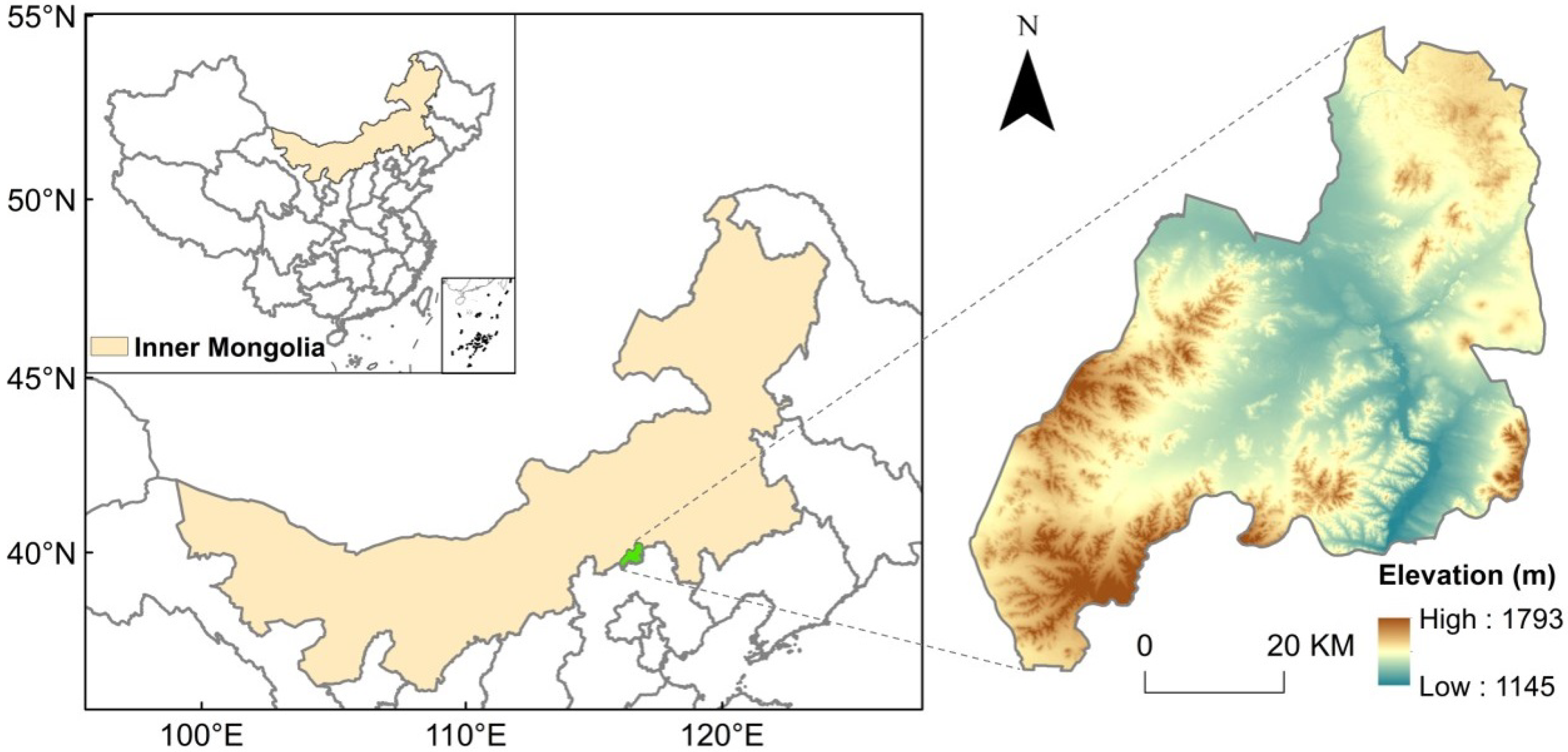
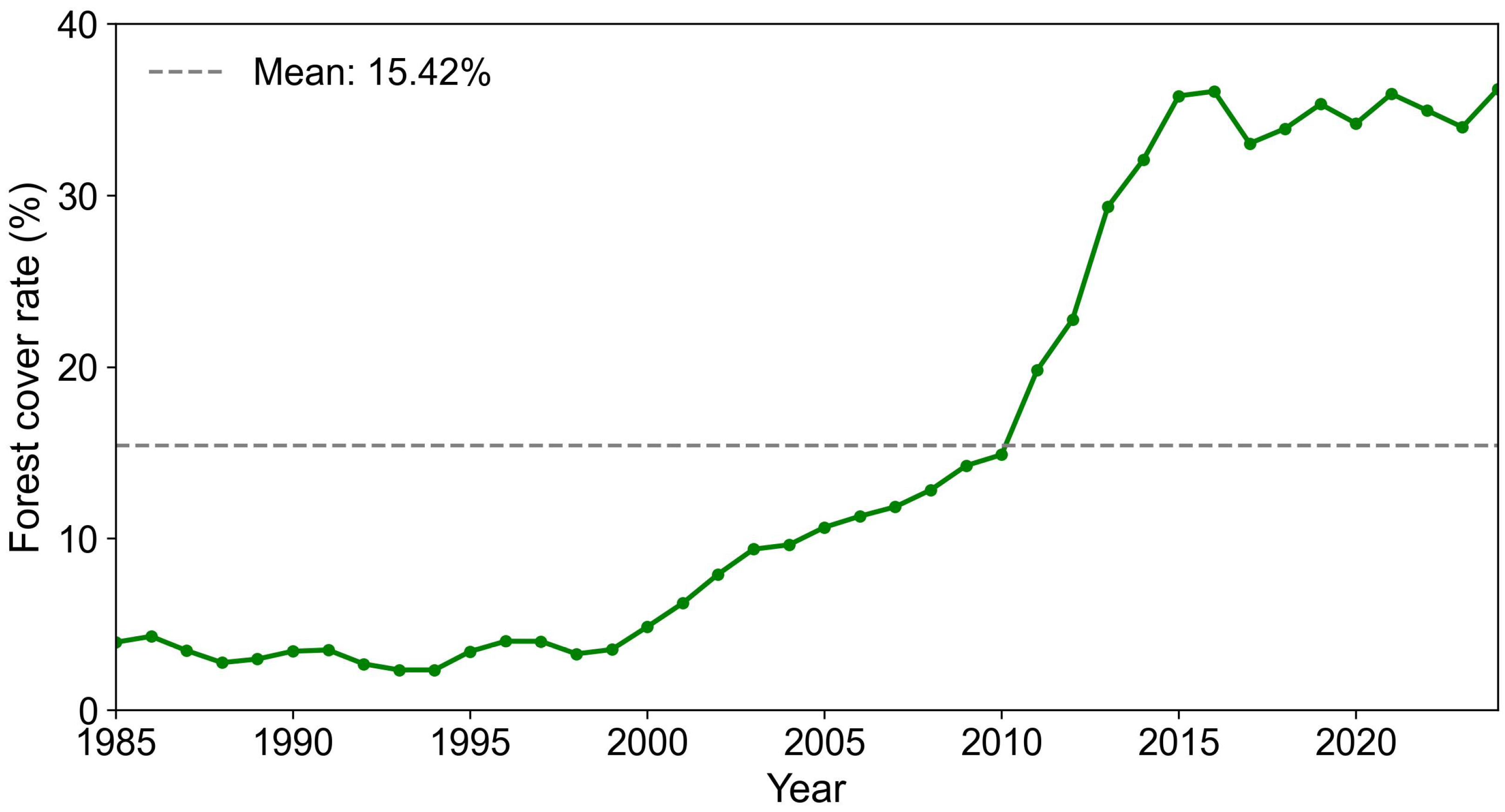
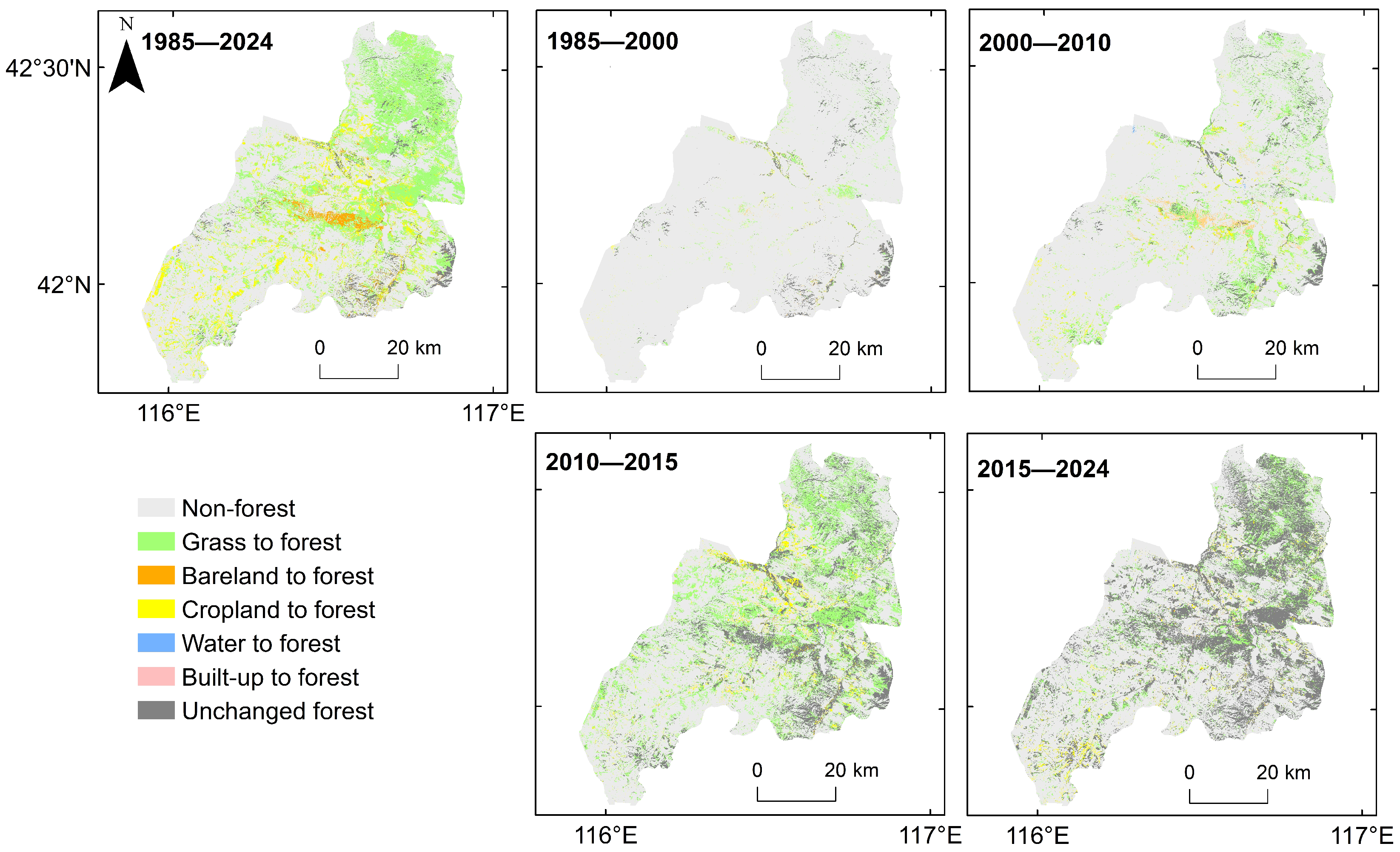
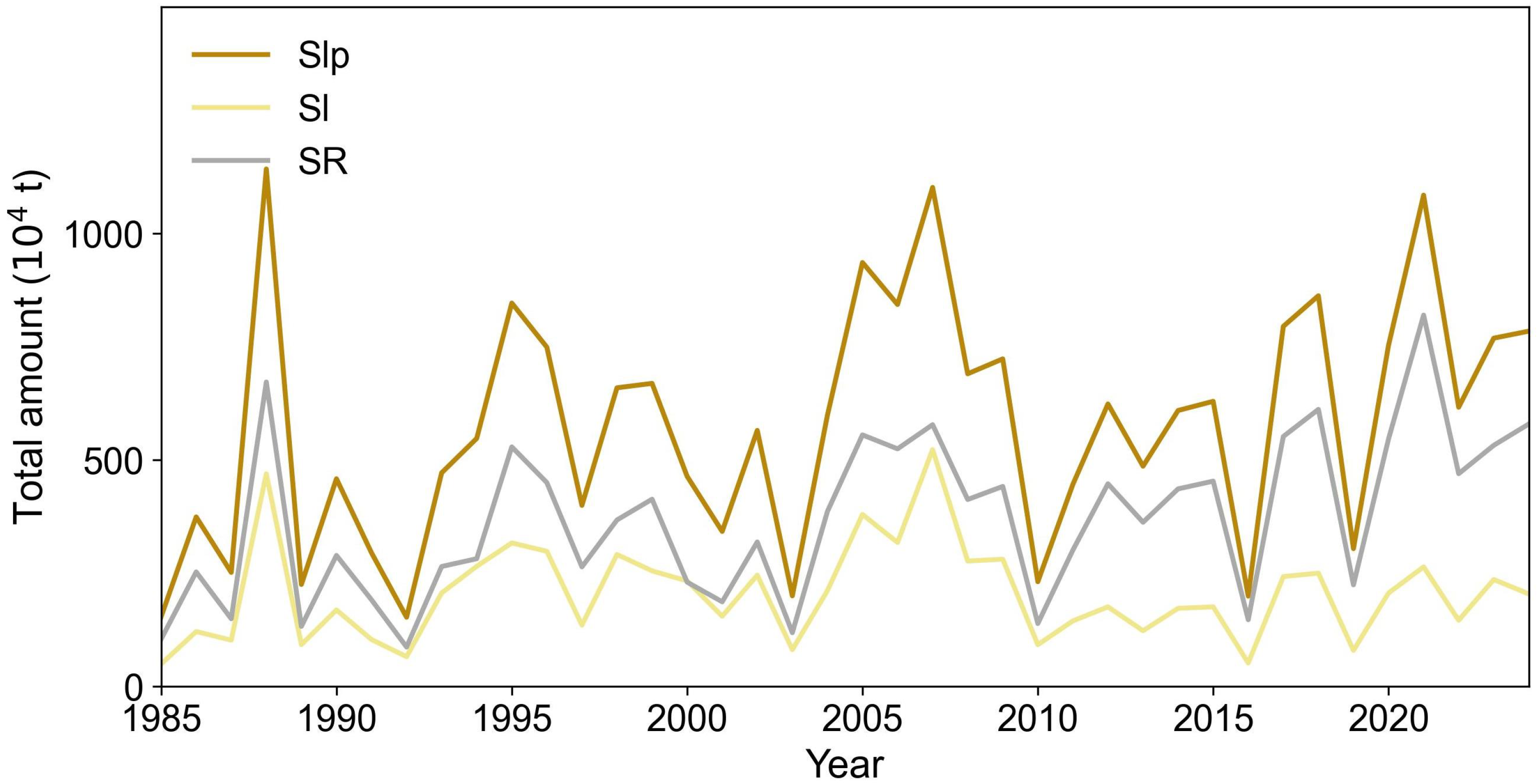
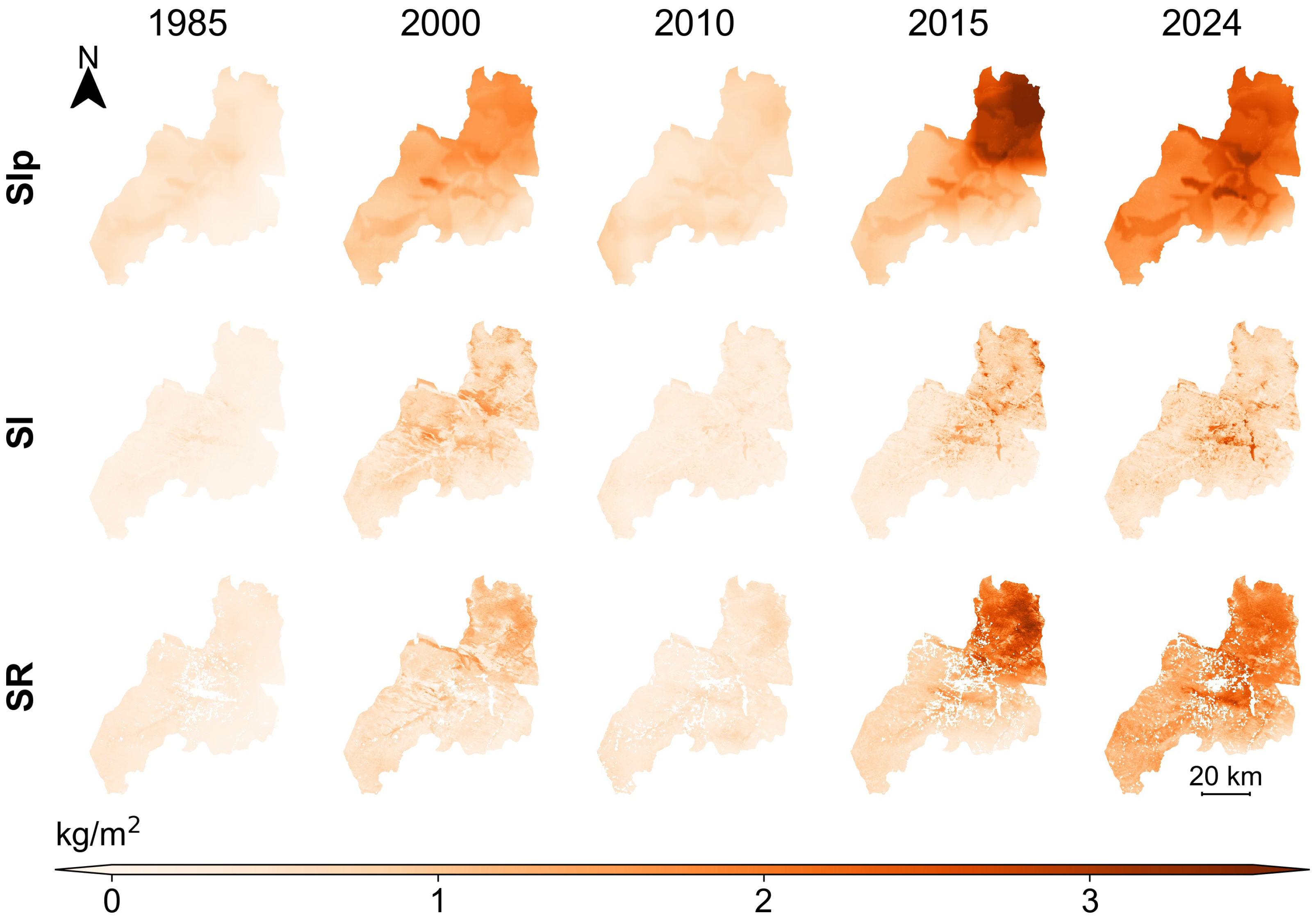

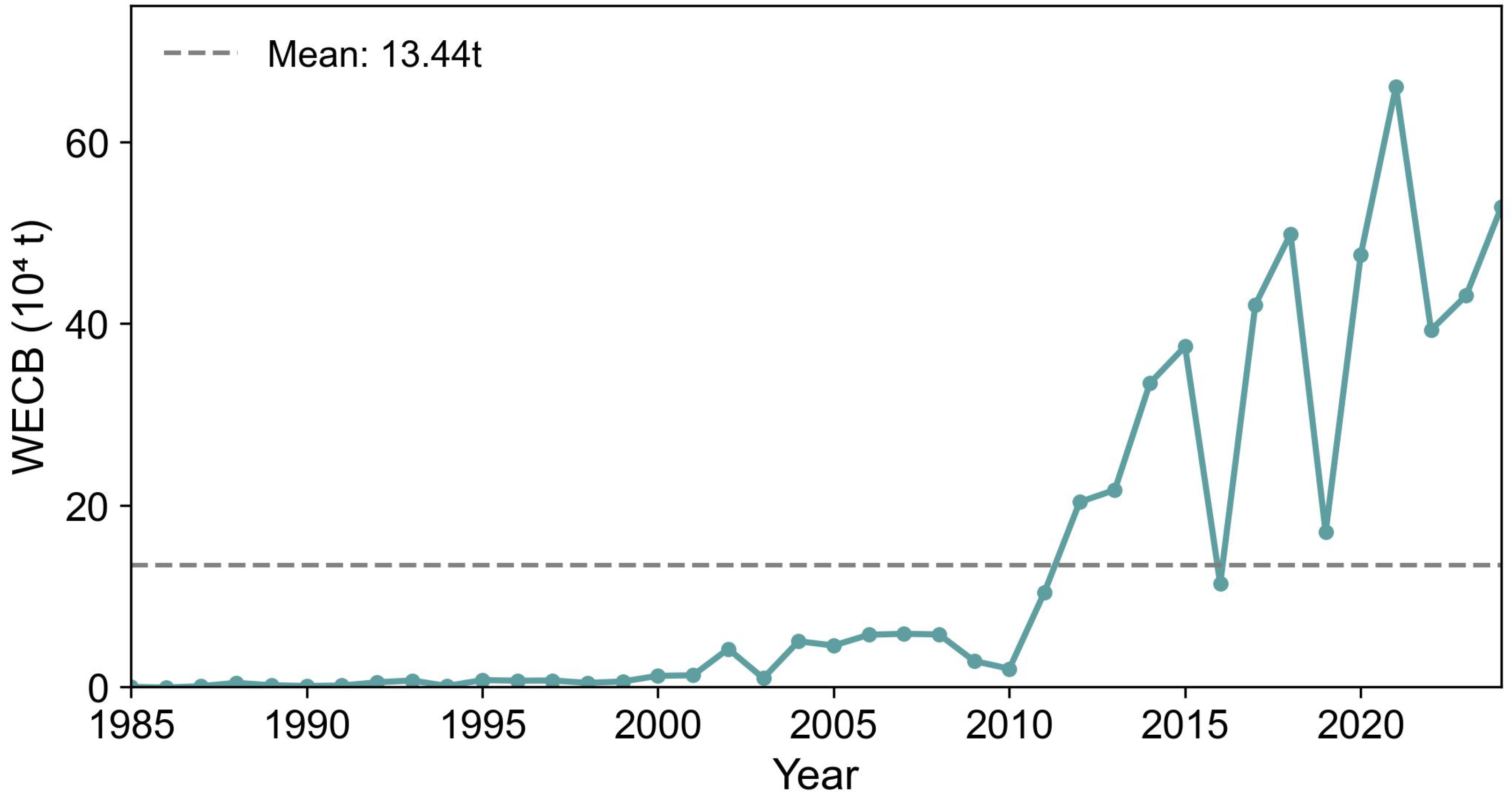

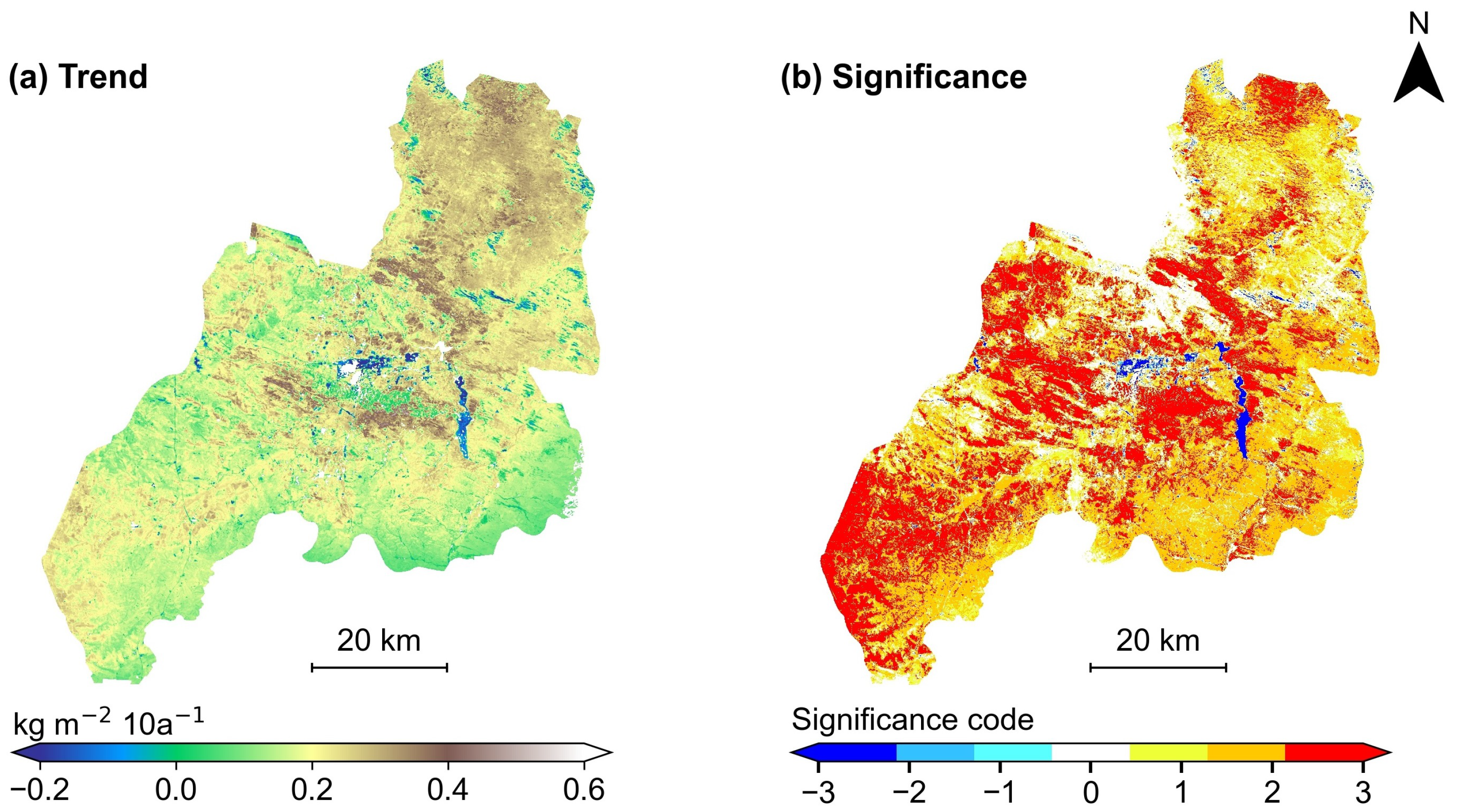
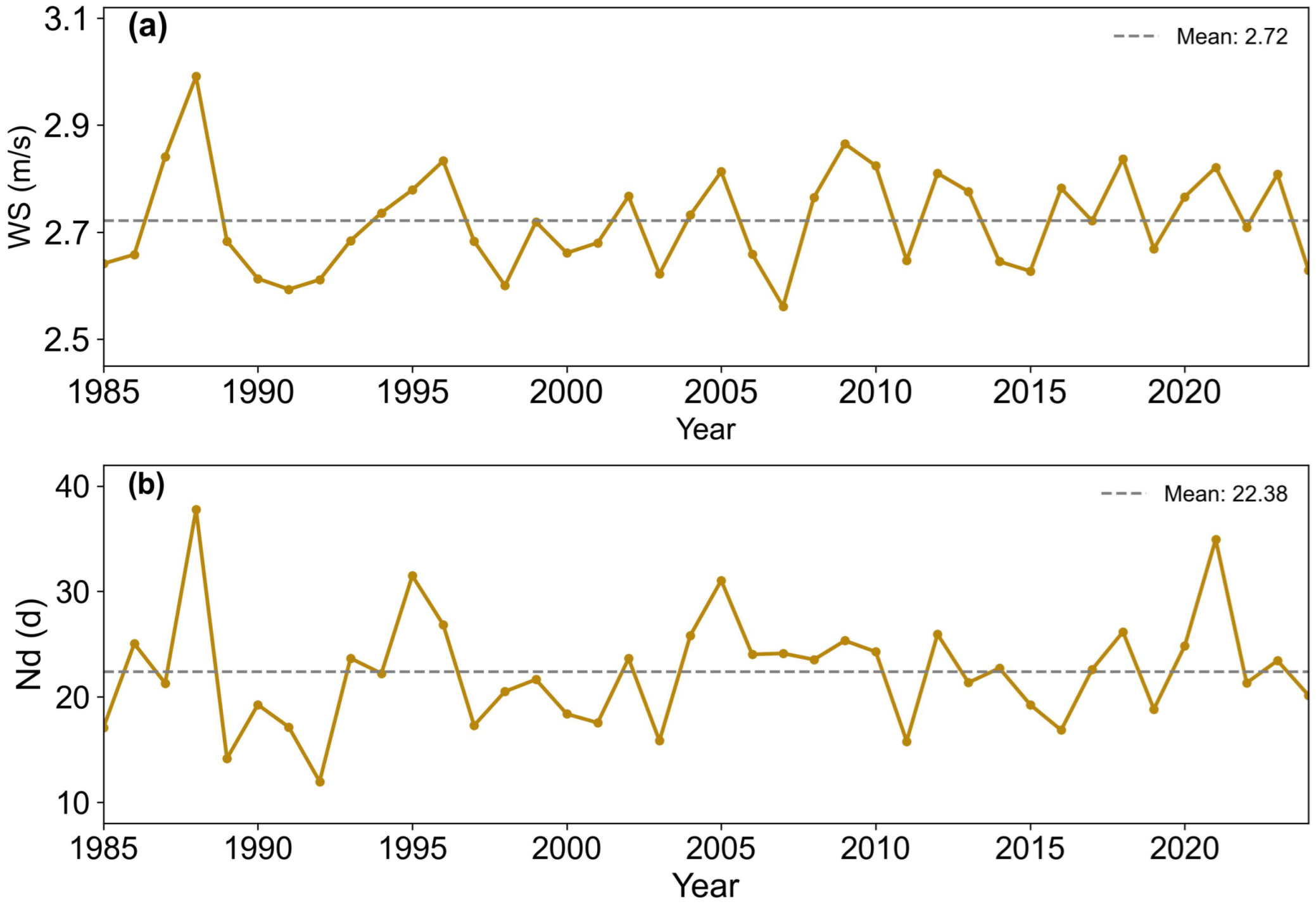

| Dataset | Variable | Resolution | Data Source |
|---|---|---|---|
| Precipitation | 0.1°/hourly | ||
| ERA5-Land | Wind speed | 0.1°/hourly | European Centre for Medium-Range Weather Forecasts (https://www.ecmwf.int/) |
| Potential evapotranspiration | 0.1°/hourly | ||
| Snow cover | Snow depth | 25 km/daily | National Tibetan Plateau Data Center (https://data.tpdc.ac.cn/home) |
| Surface reflectance | 30 m/16 d | ||
| NDVI | 30 m/16 d | ||
| Landsat | NDBI | 30 m/16 d | Google Earth Engine (https://earthengine.google.com/) |
| MNDWI | 30 m/16 d | ||
| Land cover data | Land cover type | 30 m/yearly | Zenodo (https://zenodo.org/) |
| DEM | Slope | 30 m/- | Google Earth Engine (https://earthengine.google.com/) |
| Soil data | Soil Properties | 30 arc-seconds/- | National Tibetan Plateau Data Center (https://data.tpdc.ac.cn/home) |
| Year | OA | Kappa | Year | OA | Kappa | Year | OA | Kappa | Year | OA | Kappa |
|---|---|---|---|---|---|---|---|---|---|---|---|
| 1985 | 0.96 | 0.92 | 1995 | 0.96 | 0.92 | 2005 | 0.94 | 0.90 | 2015 | 0.97 | 0.95 |
| 1986 | 0.95 | 0.91 | 1996 | 0.96 | 0.92 | 2006 | 0.93 | 0.90 | 2016 | 0.97 | 0.95 |
| 1987 | 0.95 | 0.88 | 1997 | 0.96 | 0.93 | 2007 | 0.96 | 0.93 | 2017 | 0.97 | 0.95 |
| 1988 | 0.96 | 0.90 | 1998 | 0.97 | 0.92 | 2008 | 0.96 | 0.93 | 2018 | 0.96 | 0.94 |
| 1989 | 0.95 | 0.89 | 1999 | 0.96 | 0.92 | 2009 | 0.95 | 0.93 | 2019 | 0.96 | 0.95 |
| 1990 | 0.96 | 0.92 | 2000 | 0.95 | 0.92 | 2010 | 0.96 | 0.94 | 2020 | 0.97 | 0.96 |
| 1991 | 0.95 | 0.89 | 2001 | 0.95 | 0.93 | 2011 | 0.94 | 0.91 | 2021 | 0.97 | 0.95 |
| 1992 | 0.95 | 0.89 | 2002 | 0.94 | 0.90 | 2012 | 0.95 | 0.92 | 2022 | 0.97 | 0.95 |
| 1993 | 0.96 | 0.90 | 2003 | 0.94 | 0.91 | 2013 | 0.96 | 0.94 | 2023 | 0.97 | 0.96 |
| 1994 | 0.95 | 0.90 | 2004 | 0.93 | 0.89 | 2014 | 0.96 | 0.94 | 2024 | 0.96 | 0.95 |
Disclaimer/Publisher’s Note: The statements, opinions and data contained in all publications are solely those of the individual author(s) and contributor(s) and not of MDPI and/or the editor(s). MDPI and/or the editor(s) disclaim responsibility for any injury to people or property resulting from any ideas, methods, instructions or products referred to in the content. |
© 2025 by the authors. Licensee MDPI, Basel, Switzerland. This article is an open access article distributed under the terms and conditions of the Creative Commons Attribution (CC BY) license (https://creativecommons.org/licenses/by/4.0/).
Share and Cite
Xin, Y.; Li, H.; Sun, L.; Zhou, S.; Xu, Y.; Lin, Z.; Yuan, Y. Quantifying the Contribution of Forest Restoration to Wind Erosion Control Using RWEQ—A Case Study of Duolun County in Inner Mongolia, China. Remote Sens. 2025, 17, 3861. https://doi.org/10.3390/rs17233861
Xin Y, Li H, Sun L, Zhou S, Xu Y, Lin Z, Yuan Y. Quantifying the Contribution of Forest Restoration to Wind Erosion Control Using RWEQ—A Case Study of Duolun County in Inner Mongolia, China. Remote Sensing. 2025; 17(23):3861. https://doi.org/10.3390/rs17233861
Chicago/Turabian StyleXin, Yan, Huirong Li, Linli Sun, Songqing Zhou, Yongming Xu, Zheng Lin, and Yuchen Yuan. 2025. "Quantifying the Contribution of Forest Restoration to Wind Erosion Control Using RWEQ—A Case Study of Duolun County in Inner Mongolia, China" Remote Sensing 17, no. 23: 3861. https://doi.org/10.3390/rs17233861
APA StyleXin, Y., Li, H., Sun, L., Zhou, S., Xu, Y., Lin, Z., & Yuan, Y. (2025). Quantifying the Contribution of Forest Restoration to Wind Erosion Control Using RWEQ—A Case Study of Duolun County in Inner Mongolia, China. Remote Sensing, 17(23), 3861. https://doi.org/10.3390/rs17233861










